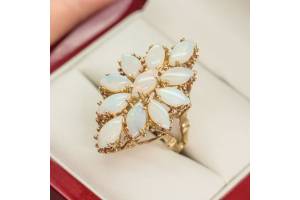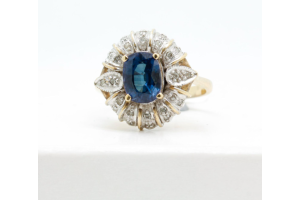
The Ultimate Guide to Authenticating Vintage Jewellery is here to give you a detailed understanding of the world of vintage jewellery. It's important to authenticate these pieces not only for their monetary value but also to appreciate their historical and sentimental worth.
To properly authenticate vintage jewellery, you'll need to:
Identify hallmarks
Examine craftsmanship
Recognize design elements from different eras
This guide will delve into each of these steps, providing you with the knowledge necessary to make informed decisions.
Our goal with this guide is to equip you with practical methods for authenticating vintage jewellery, so you can confidently determine the authenticity and value of your cherished discoveries.
Understanding Vintage vs. Antique Jewellery
Vintage and antique are terms often used interchangeably, yet they have distinct meanings in the world of jewellery.
Vintage Jewellery
Typically defined as pieces that are at least 20 years old. This means that items from the early 2000s can be considered vintage today. Vintage jewellery often reflects the trends and styles of its era, offering a nostalgic charm.
Antique Jewellery
Refers to pieces that are over 100 years old. These items often hold significant historical value and are rarer than their vintage counterparts. An example would be jewellery from the Victorian era, which is now well over a century old.
Understanding these definitions is crucial for valuation. Vintage jewellery may be more common and accessible, while antique pieces can command higher prices due to their age and rarity. Distinguishing between the two ensures accurate appraisals and informed purchasing decisions.
Read our full blog on Why Antique & Vintage Jewellery is Making a Come back
- Identifying Hallmarks and Signatures
Hallmarks and signatures are crucial for verifying the authenticity of vintage jewellery. These markings reveal important details about the piece, such as where it was made, what metals were used, and sometimes even when it was created.
Role of Hallmarks
Origin Identification
Hallmarks can reveal the country where the jewellery was made. For instance, a lion passant indicates sterling silver from the UK.
Metal Content
Hallmarks also specify the purity of metals used. Commonly found marks include "925" for sterling silver and "750" for 18 karat gold.
Historical Context of UK Hallmarks
UK hallmarks became compulsory in the 1920s, adding a layer of traceability to British jewellery. These marks often include:
Assay Office Mark
Indicates the city where the item was tested.
Example: A leopard's head stands for London.
Date Letter
A letter indicating the year of assay.
Example: The letter "A" might represent a specific year based on the Assay Office's system.
Recognizing Designer Signatures
Designer signatures can be another reliable means of authentication:
Signed Pieces
Renowned designers often mark their creations with unique signatures or logos.
Example: The iconic "Tiffany & Co." stamp signifies a piece created by this prestigious brand.
Collector Value
Pieces with recognizable signatures generally hold higher value due to their confirmed provenance.
Understanding these hallmarks and signatures allows you to authenticate and accurately date vintage jewellery pieces, enhancing their value and appeal.
2. Examining Craftsmanship and Materials
Craftsmanship serves as a crucial indicator when dating jewellery pieces. The quality of craftsmanship often reflects the era in which a piece was made. Handcrafted items typically exhibit intricate details and unique designs, characteristic of earlier periods. Machine-made jewellery, which became more prevalent from the late 19th century onwards, often lacks this level of detail but can be identified by uniformity and precision.
Differences Between Handcrafted and Machine-Made Items
Handcrafted Jewellery: Shows signs of individual artistry, slight imperfections, and intricate detailing.
Machine-Made Jewellery: Features uniformity, precision, and often simpler designs compared to handcrafted pieces.
Popular Materials Used in Different Eras
Understanding the materials used in different historical contexts enriches your knowledge about vintage jewellery:
Victorian Era (1837-1901): Favored gold, silver, jet, human hair, and semi-precious stones. Intricate engravings and sentimental motifs were popular.
- Victorian era necklace featuring intricate engravings.
Art Deco Era (1919-1939): Known for bold geometric shapes and the use of platinum, white gold, diamonds, and brightly colored gemstones such as emeralds and sapphires.
- Art Deco pendant highlighting geometric design.
Recognizing these materials can provide significant clues about the period a piece belongs to. This understanding not only aids in authentication but also enhances appreciation for the historical context behind each piece.
3. Recognizing Design Elements From Different Eras
Understanding the design elements characteristic of various historical periods is crucial in authenticating vintage jewellery. Each era has distinct styles that reflect the cultural and artistic movements of its time.
Victorian (1800s-1900)
Intricate Designs: Known for elaborate and detailed craftsmanship.
Sentimental Motifs: Frequently features hearts, flowers, and lockets.
Materials: Commonly used gold, silver, and gemstones like garnets and pearls.
Edwardian (1901-1914)
Delicate Lace-like Patterns: Often incorporates filigree work and light, airy designs.
Elegance: Emphasizes sophistication with diamond and platinum pieces.
Nature Themes: Includes motifs such as bows, garlands, and laurel wreaths.
Art Nouveau (1895-1915)
Organic Forms: Features flowing lines and natural shapes like leaves and flowers.
Whimsical Aesthetics: Incorporates mythological creatures and feminine silhouettes.
Materials: Utilizes enamel, opals, moonstones, and other semi-precious stones.
Art Deco (1919-1939)
Bold Geometric Shapes: Characterized by sharp lines, symmetry, and streamlined forms.
Vibrant Colors: Often uses contrasting colors through gemstones like emeralds, rubies, and sapphires.
Modern Influence: Reflects the industrial age with an emphasis on glamour and luxury.
Retro Mid Century (1935-1950s)
Larger Statement Pieces: Features bold designs often influenced by Hollywood glamour.
Curvy Lines & Floral Motifs: Includes oversized brooches and bracelets with curvilinear patterns.
Materials: Frequently uses gold with large colorful gemstones or synthetic stones.
Recognizing these design elements helps in dating jewellery accurately to specific historical periods. Identifying these styles can significantly aid in determining the authenticity and value of vintage pieces.
4. Evaluating Fasteners and Clasps for Dating Purposes
Fasteners and clasps are crucial clues when it comes to dating vintage jewellery. Each era had its own distinct styles and mechanisms, making them valuable indicators for authentication.
Why Clasps Matter in Dating Vintage Jewellery
Clasps do more than just hold a piece of jewellery together; they also reveal information about when it was made. By looking at the design and mechanism of a clasp, you can often determine the decade or even the exact year a piece was created.
Examples of Clasps Popular in Specific Decades
Box Clasps (Mid-20th Century): Common during the 1950s and 1960s, these clasps have a box-like structure with a tab that fits securely.
Hook Clasps (1970s): Simple hook clasps became widely used in the 1970s. These fasteners are easy to use and often found on necklaces.
Barrel Clasps (1930s-1940s): Widely used during the Retro period, barrel clasps consist of two parts that screw together, providing a secure fit.
Spring Ring Clasps (Late 19th Century): Introduced in the late 1800s, these small circular clasps are still popular today but were particularly common in Victorian jewellery.
By getting to know these different clasp types and their corresponding time periods, you'll greatly improve your ability to accurately date vintage jewellery.
5. Testing for Metal Content and Purity
Understanding metal purity is crucial for valuing vintage jewellery accurately. The composition of metals such as gold and silver significantly impacts both the aesthetic and monetary value of a piece.
Common Markings
Sterling Silver
Often marked with "925" or "958", indicating the percentage of pure silver (92.5% and 95.8%, respectively).
Gold Karat Weights
Gold items are typically stamped with their karat weight:
"10K" (41.7% pure gold)
"14K" (58.3% pure gold)
"18K" (75% pure gold)
"24K" (99.9% pure gold)
Testing Methods
Testing methods for metal content involve both non-invasive and invasive techniques:
Acid Testing: Uses nitric acid to test the reaction on a small scratch of the metal.
Electronic Testing: Employs devices that measure metal conductivity to determine purity.
X-Ray Fluorescence (XRF): A non-invasive method providing detailed compositional analysis.
Accurate identification of these markings and understanding the methods used in testing can greatly aid in authenticating vintage pieces, ensuring their true value is recognized.
6. Assessing Condition Impact on Valuation
Condition assessment plays a crucial role in determining the value of vintage jewellery. Signs of wear, such as minor scratches or tarnish, can add character and authenticity to a piece, reflecting its journey through time. However, excessive damage may significantly lower its value.
Factors to consider when assessing condition:
Wear and Tear: Examine for any signs of regular usage. Minor blemishes might be acceptable and even desirable, but deep scratches or severe wear could be detrimental.
Stone Condition: Check for any chips, cracks, or replacements in gemstones. Original stones in good condition are highly valued.
Metal Integrity: Look for any signs of metal fatigue or repairs. Repaired pieces might lose some value compared to those in original condition.
Functionality: Ensure that clasps, hinges, and other moving parts work correctly. Non-functional components can decrease the item's worth.
Understanding these factors will enable you to make an informed valuation of your vintage jewellery pieces. For more insights into what makes vintage jewellery valuable, or if you're considering selling your vintage pieces.
Moreover, if you're looking into authenticating antique jewelry, understanding the condition assessment factors is vital. This knowledge is particularly useful when buying a vintage engagement ring, as it helps ensure that you're making a sound investment.
7. Seeking Expert Appraisal for Authenticity Insights
Consulting with a reputable jeweler or appraiser specializing in vintage jewellery provides several benefits:
Accurate Valuation: Experts can offer precise evaluations based on market trends and historical data.
Authenticity Verification: They can identify genuine pieces and spot counterfeits using advanced tools and techniques.
Detailed Reports: Expect comprehensive documentation, including photographs, descriptions, and appraised value.
During an appraisal process:
Initial Consultation: Discuss your piece’s history and any known details.
Physical Examination: The expert inspects hallmarks, craftsmanship, materials, and design elements.
Testing: Advanced methods like X-ray fluorescence (XRF) may be used to verify metal content.
Valuation Report: Receive a detailed report outlining the item’s authenticity, condition, and estimated value.
Hiring an expert ensures you receive well-informed insights into your vintage jewellery's authenticity and worth.
Conclusion: Empower Yourself with Knowledge on Authenticating Vintage Jewellery!
With insights from The Ultimate Guide to Authenticating Vintage Jewellery, you're now ready to explore the fascinating world of vintage pieces with confidence. Use these techniques to evaluate hallmarks, craftsmanship, and design elements in your future purchases. Each step you take will deepen your understanding, making you a more discerning and knowledgeable collector. Happy hunting!





